
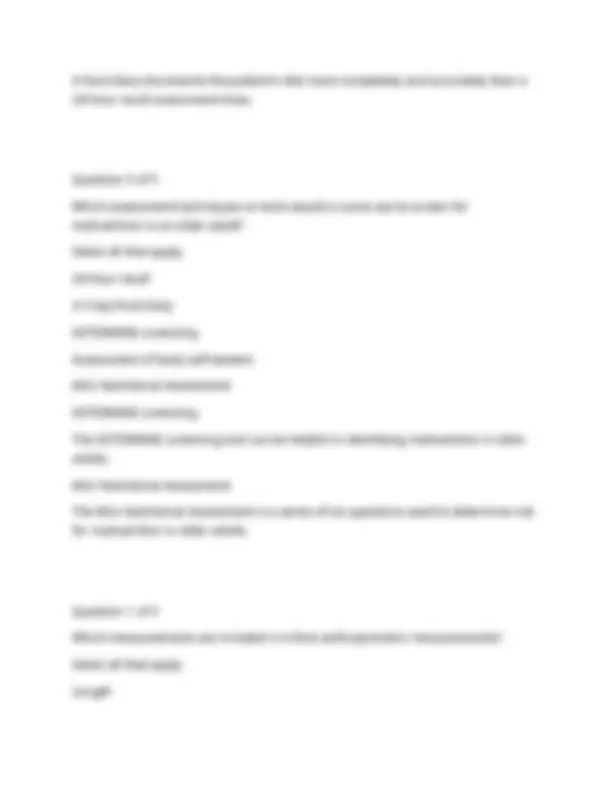
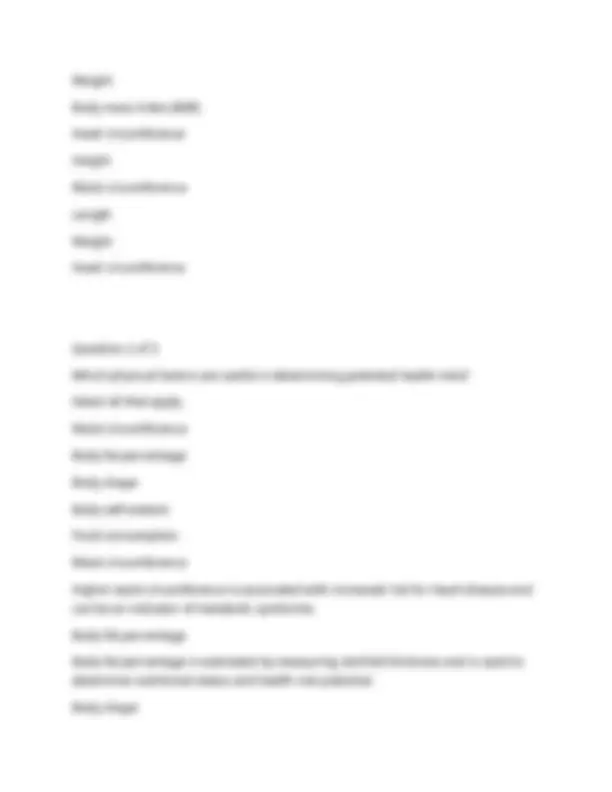
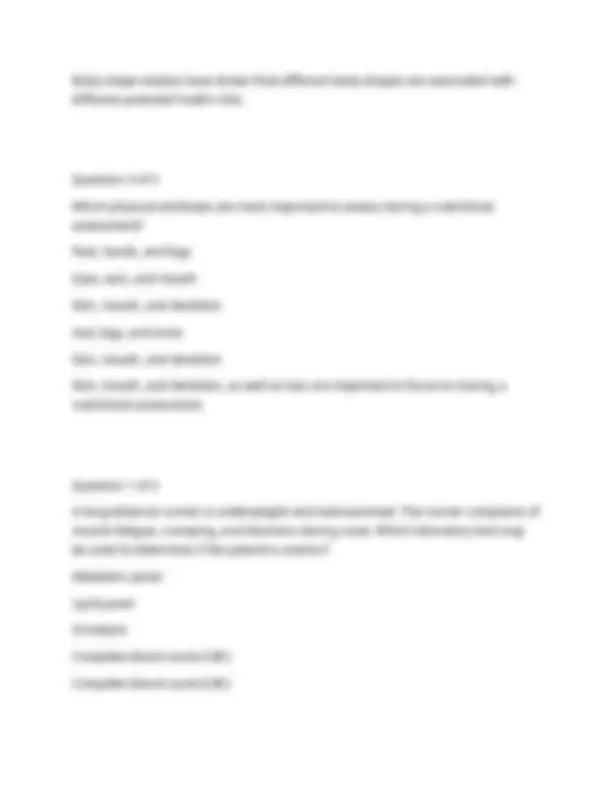
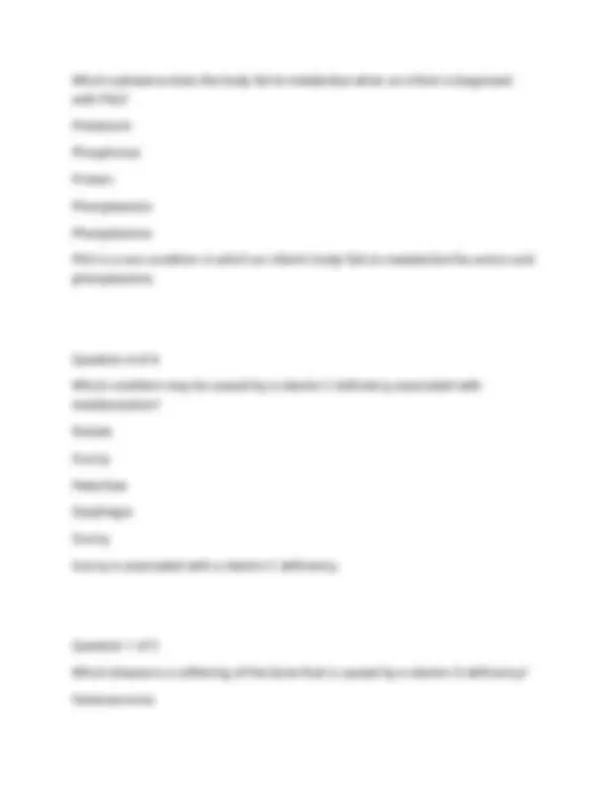
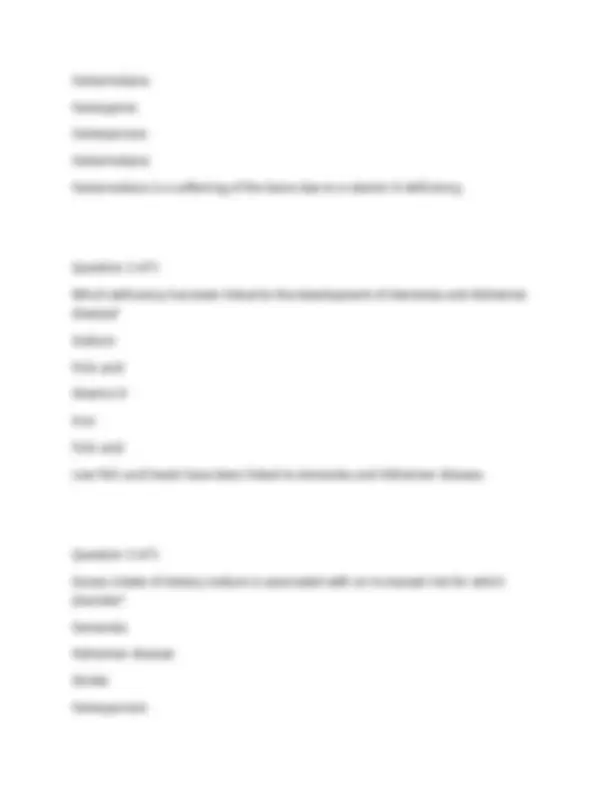
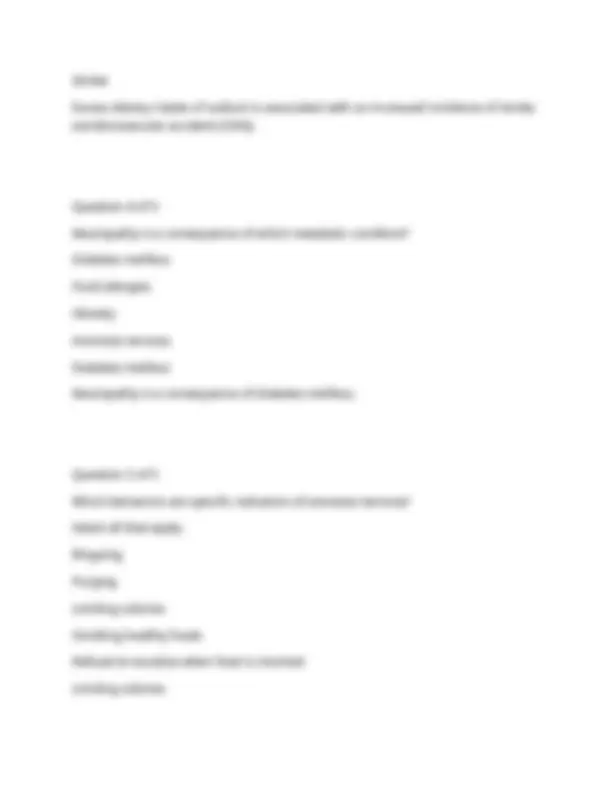
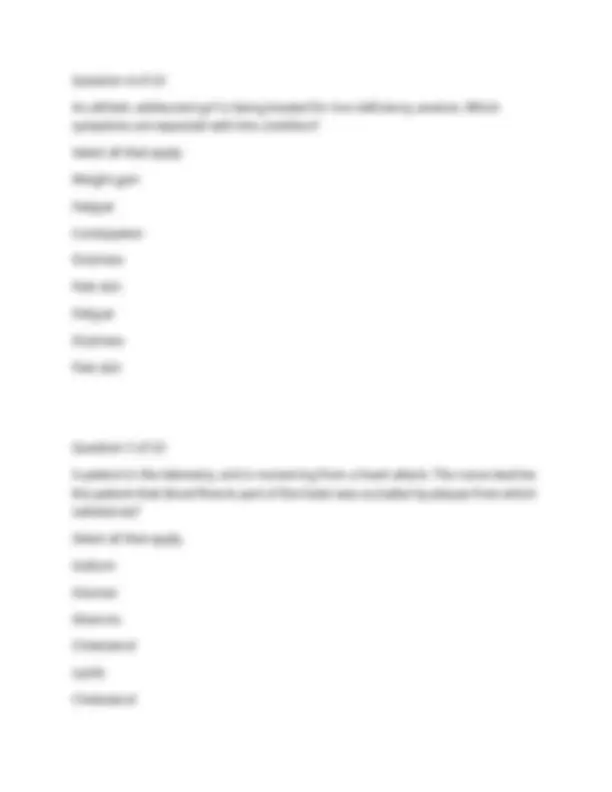
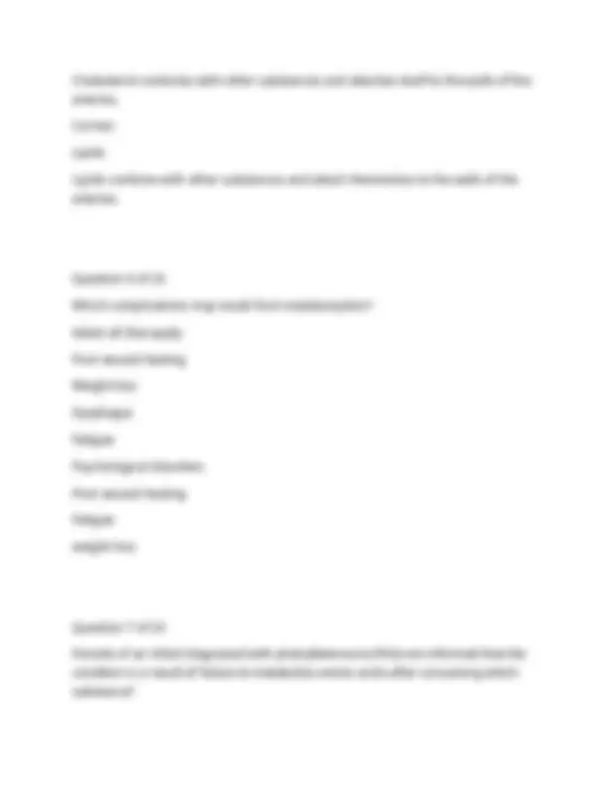
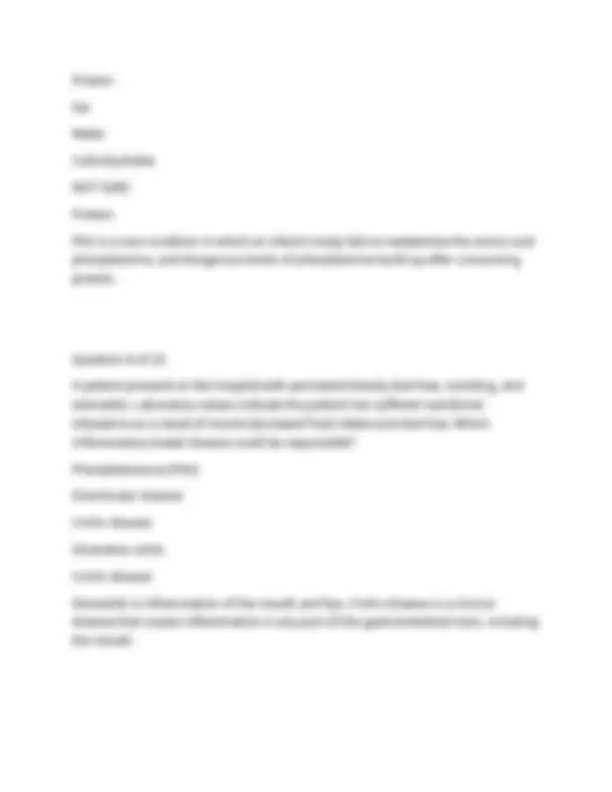
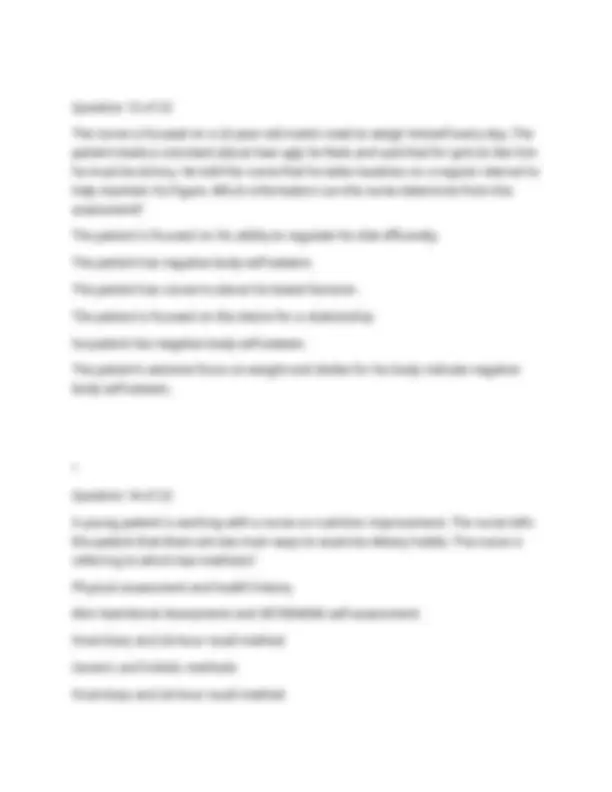
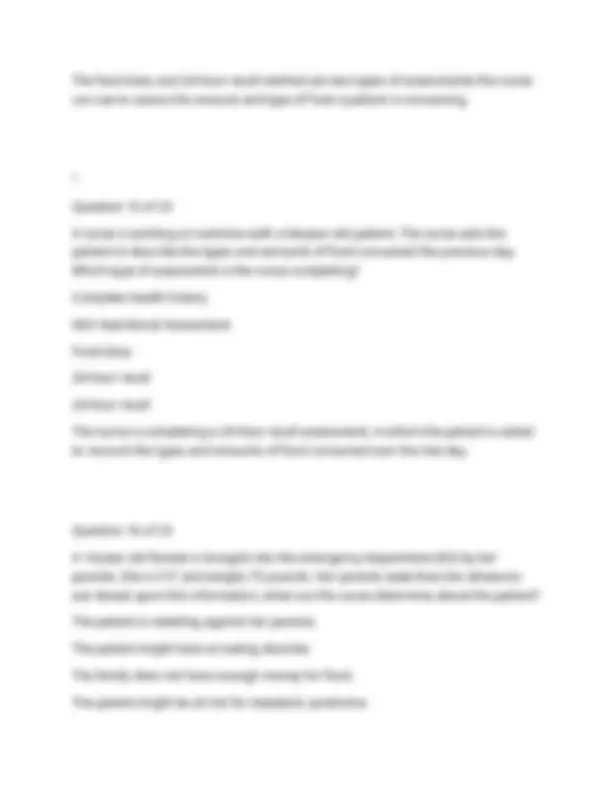
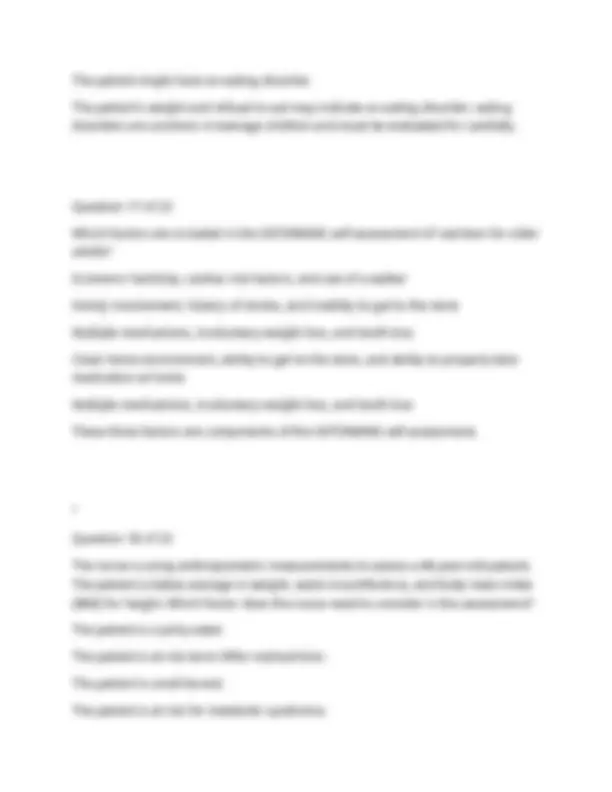
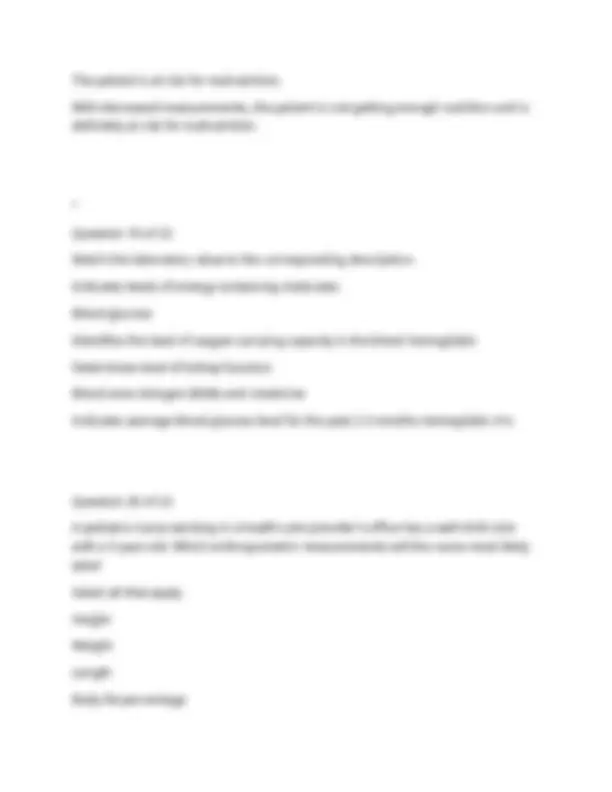
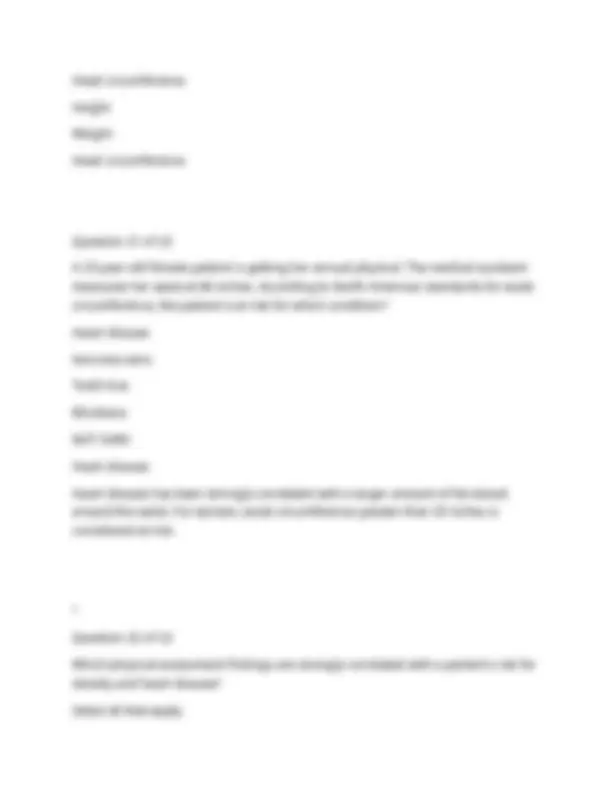
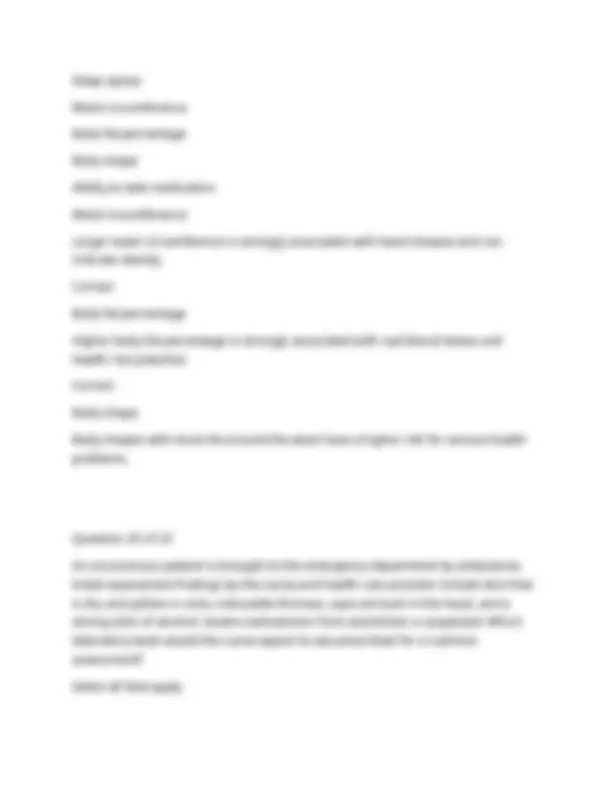



Study with the several resources on Docsity

Earn points by helping other students or get them with a premium plan


Prepare for your exams
Study with the several resources on Docsity

Earn points to download
Earn points by helping other students or get them with a premium plan
Community
Ask the community for help and clear up your study doubts
Discover the best universities in your country according to Docsity users
Free resources
Download our free guides on studying techniques, anxiety management strategies, and thesis advice from Docsity tutors
BSN 225 MALNUTRITION OVER 50 QUESTIONS FREQUENTLY TESTED AND ALL CORRECT ANSWERS
Typology: Exams
1 / 24

This page cannot be seen from the preview
Don't miss anything!

















Question 1 of 5 Which component is a key element of a full nutritional nursing assessment? Complete health history Neurologic assessment Home medication review Range-of-motion assessment Complete health history A complete health history provides essential information about dietary habits. Question 2 of 5 Which question would a nurse most likely use to gather information about a patient's body self-esteem? "What is your typical diet for a day?" "How often do you weigh yourself?" "Have you noticed any changes in appetite or food intake?" "While eating, do you experience any difficulty chewing or swallowing?" " How often do you weigh yourself?"
Asking how often a patient weighs him- or herself can provide information about how the patient views his or her body and is associated with assessment of body self-esteem. Question 3 of 5 Which statement describes the main disadvantage of using the 24-hour recall method to assess a patient's dietary history? The method involves every member of the family. The large quantity of data collected is difficult to process. The patient's recall may not reflect food consumption for a typical day. Patients usually do not want to share the last 24 hours of food intake. The patient's recall may not reflect food consumption for a typical day. Data about a 24-hour period may not accurately reflect a patient's dietary history because a patient's eating habits can vary from day to day. Question 4 of 5 What statement describes the benefit of a food diary? It provides data that covers weeks or months. It is evaluated directly by the health care provider. It is in a digital format that is easy to share with the health care team. It provides a more complete and accurate display of a patient's dietary pattern. It provides a more complete and accurate display of a patient's dietary pattern.
Weight Body mass index (BMI) Head circumference Height Waist circumference Length Weight Head circumference Question 2 of 3 Which physical factors are useful in determining potential health risks? Select all that apply. Waist circumference Body fat percentage Body shape Body self-esteem Food consumption Waist circumference Higher waist circumference is associated with increased risk for heart disease and can be an indicator of metabolic syndrome. Body fat percentage Body fat percentage is estimated by measuring skinfold thickness and is used to determine nutritional status and health risk potential. Body shape
Body shape studies have shown that different body shapes are associated with different potential health risks. Question 3 of 3 Which physical attributes are most important to assess during a nutritional assessment? Feet, hands, and legs Eyes, ears, and mouth Skin, mouth, and dentition Hair, legs, and arms Skin, mouth, and dentition Skin, mouth, and dentition, as well as hair, are important to focus on during a nutritional assessment. Question 1 of 3 A long-distance runner is underweight and malnourished. The runner complains of muscle fatigue, cramping, and dizziness during races. Which laboratory test may be used to determine if the patient is anemic? Metabolic panel Lipid panel Urinalysis Complete blood count (CBC) Complete blood count (CBC)
Question 1 of 4 Which condition is related to inflammation and can affect any part of the gastrointestinal (GI) tract? Phenylketonuria (PKU) Crohn disease Diverticular disease Ulcerative colitis Crohn disease Crohn disease is a chronic disease that causes inflammation in any part of the GI tract, from the mouth to the anus. Question 2 of 4 Dysphagia may result from which condition? Rickets Scurvy Anemia Stroke Stroke Dysphagia may result from the effects of a stroke. Question 3 of 4
Which substance does the body fail to metabolize when an infant is diagnosed with PKU? Potassium Phosphorus Protein Phenylalanine Phenylalanine PKU is a rare condition in which an infant's body fails to metabolize the amino acid phenylalanine. Question 4 of 4 Which condition may be caused by a vitamin C deficiency associated with malabsorption? Rickets Scurvy Petechiae Dysphagia Scurvy Scurvy is associated with a vitamin C deficiency. Question 1 of 5 Which disease is a softening of the bone that is caused by a vitamin D deficiency? Osteosarcoma
Stroke Excess dietary intake of sodium is associated with an increased incidence of stroke (cerebrovascular accident [CVA]). Question 4 of 5 Neuropathy is a consequence of which metabolic condition? Diabetes mellitus Food allergies Obesity Anorexia nervosa Diabetes mellitus Neuropathy is a consequence of diabetes mellitus. Question 5 of 5 Which behaviors are specific indicators of anorexia nervosa? Select all that apply. Bingeing Purging Limiting calories Omitting healthy foods Refusal to socialize when food is involved Limiting calories
Omitting healthy foods Refusal to socialize when food is involved Question 1 of 23 The nurse is caring for an older adult who lives alone. The nurse becomes concerned that the patient is getting inadequate nutrition based on which neurologic manifestations? Select all that apply. Decreased alertness Slower muscle response time Decreased hearing Decreased visual acuity Slower problem-solving Decreased alertness Slower muscle response time Slower problem-solving ° Question 2 of 23 The nurse is caring for an older adult with Alzheimer disease and a secondary diagnosis of malnutrition. Which neurologic functions affect the patient's ability to receive adequate nutrition? Select all that apply.
Question 4 of 23 An athletic adolescent girl is being treated for iron deficiency anemia. Which symptoms are expected with this condition? Select all that apply. Weight gain Fatigue Constipation Dizziness Pale skin Fatigue Dizziness Pale skin Question 5 of 23 A patient in the telemetry unit is recovering from a heart attack. The nurse teaches the patient that blood flow to part of the heart was occluded by plaque from which substances? Select all that apply. Sodium Glucose Vitamins Cholesterol Lipids Cholesterol
Cholesterol combines with other substances and attaches itself to the walls of the arteries. Correct Lipids Lipids combine with other substances and attach themselves to the walls of the arteries. Question 6 of 23 Which complications may result from malabsorption? Select all that apply. Poor wound healing Weight loss Dysphagia Fatigue Psychological disorders Poor wound healing Fatigue weight loss Question 7 of 23 Parents of an infant diagnosed with phenylketonuria (PKU) are informed that the condition is a result of failure to metabolize amino acids after consuming which substance?
Question 9 of 23 A high school nurse notes that girls on the cross-country team eat together each day. She notes that one of the girls only consumes an apple each day at lunch and has experienced a decline in her athletic performance. Which condition does the nurse suspect in this girl? Phenylketonuria (PKU) Bulimia nervosa Anorexia nervosa Crohn disease Anorexia nervosa Question 10 of 23 The nurse is completing the physical assessment on a patient just admitted to the hospital. The nurse is focusing on the nutritional aspects of this assessment. Which factors should the nurse pay close attention to when examining the patient? Skin, hair, and dentition Eyes, ears, nose, and throat How the patient is feeling The patient's steady gait Skin, hair, and dentition A patient's skin, hair, and dentition can be strong indicators of nutritional status. Question 11 of 23
A patient has been admitted to the hospital for malnutrition, and the nurse is explaining the plan of care. When the nurse comes in to take blood for the physical assessment, which statement is most appropriate for the nurse to make to the patient? "Taking a patient's blood is standard procedure." "A laboratory study will allow us as your health care providers to thoroughly assess your nutritional status." "The health care provider has prescribed this procedure." "A blood test is necessary to see what is lacking from your diet." "A laboratory study will allow us as your health care providers to thoroughly assess your nutritional status." This explanation conveys to the patient the importance of laboratory studies as part of a thorough nutritional assessment. Question 12 of 23 The nurse weighs a 13-year-old female patient, asks her how she feels about her body, and collects data about the different types of foods she likes to eat during the day. Which type of assessment is the nurse performing? Cardiac assessment Psychological assessment Health history Fall-risk assessment Health history A health history includes the type of foods a patient eats, the patient's body self- esteem, and physical symptoms the patient may be experiencing.
The food diary and 24-hour recall method are two types of assessments the nurse can use to assess the amount and type of food a patient is consuming. ° Question 15 of 23 A nurse is working on nutrition with a 64-year-old patient. The nurse asks the patient to describe the types and amounts of food consumed the previous day. Which type of assessment is the nurse completing? Complete health history Mini Nutritional Assessment Food diary 24-hour recall 24-hour recall The nurse is completing a 24-hour recall assessment, in which the patient is asked to recount the types and amounts of food consumed over the last day. Question 16 of 23 A 14-year-old female is brought into the emergency department (ED) by her parents. She is 5'3" and weighs 75 pounds. Her parents state that she refuses to eat. Based upon this information, what can the nurse determine about the patient? The patient is rebelling against her parents. The patient might have an eating disorder. The family does not have enough money for food. The patient might be at risk for metabolic syndrome.
The patient might have an eating disorder. The patient's weight and refusal to eat may indicate an eating disorder; eating disorders are common in teenage children and must be evaluated for carefully. Question 17 of 23 Which factors are included in the DETERMINE self-assessment of nutrition for older adults? Economic hardship, cardiac risk factors, and use of a walker Family involvement, history of stroke, and inability to get to the store Multiple medications, involuntary weight loss, and tooth loss Clean home environment, ability to get to the store, and ability to properly take medication at home Multiple medications, involuntary weight loss, and tooth loss These three factors are components of the DETERMINE self-assessment. ° Question 18 of 23 The nurse is using anthropometric measurements to assess a 46-year-old patient. The patient is below average in weight, waist circumference, and body mass index (BMI) for height. Which factor does the nurse need to consider in the assessment? The patient is a picky eater. The patient is at risk term-39for malnutrition. The patient is small-boned. The patient is at risk for metabolic syndrome.